Contents
About Thai Mueang
Thai Mueang (ท้ายเหมือง) is a district located in Phang Nga Province, southern Thailand. The quaint beach town within lies approximately 70 to 80 kilometers (43 to 50 miles) north of Phuket.
The area's history is deeply rooted in the tin mining industry, which boomed between the 50s and 80s. A once vibrant area with entertainment venues and plenty of restaurants now appears as a quiet backwater, spared of modern commercial development due to its national park status.
Recently, Thai Mueang has been brought to the awareness of many a foreign by popular expat personality and author Steve Rosse, who initially dreamt of retiring in Phuket. However, upon arrival to Phuket many years after he had last visited, he despaired at how overrun with expats, tourism, and development it had become and decided to explore other options.
A friend led him to the delightful Thai Mueang. He fell in love, and the rest, as they say, is history.
If you're looking for night life such as bars and clubs, forget it. This sleepy town goes to bed early and gets up at the crack of dawn. Thai Mueang is a place to escape the noise of big cities and tourist hotspots.
The district is divided into six sub-districts (tambons), which are further subdivided into 40 villages (moobans). Thai Mueang itself has township (thesaban) status. There are six tambon administrative organizations.
| No. | Name | Thai name | Villages | Pop. | |
|---|---|---|---|---|---|
| 1. | Thai Mueang | ท้ายเหมือง | 9 | 11,172 | |
| 2. | Na Toei | นาเตย | 9 | 8,919 | |
| 3. | Bang Thong | บางทอง | 7 | 5,075 | |
| 4. | Thung Maphrao | ทุ่งมะพร้าว | 11 | 8,908 | |
| 5. | Lam Phi | ลำภี | 7 | 4,827 | |
| 6. | Lam Kaen | ลำแก่น | 6 | 6,646 |
Source: Wikipedia
How to Get to Thai Mueang from Phuket
By Car:
The journey from Phuket to Thai Mueang typically takes about 1.5 hours by car, depending on traffic conditions. To travel from Phuket you need to cross the Sarasin Bridge, a significant landmark and a key transportation route spanning the Pak Prah Strait and connecting Phuket island to the mainland of Thailand.
Constructed in 1967, the Sarasin Bridge replaced ferry services as the primary means of transportation between the island and the mainland, significantly improving accessibility and facilitating economic development in the region.
The bridge is named after Thanom Sarasin, who served as the Governor of Phuket Province at the time of its construction. In addition to its functional significance, the Sarasin Bridge also offers scenic views of the surrounding coastline and Pak Prah Strait, making it a popular spot for tourists to stop and take photographs.
From Phuket, take Route 402 to Route 4 (Phetkasem Road), which connects Phuket to Thai Mueang. The journey typically takes around 1.5 hours.
By Bus:
You can catch a bus from the Phuket Bus Terminal 2 (also known as the new bus terminal) located in Phuket Town.
Buses heading northbound along Route 4 (Phetkasem Road) pass through Thai Mueang. The journey may take around 2 to 3 hours, depending on the bus schedule and stops along the way. Minivans also operate between Phuket and Thai Mueang, and can be found departing at the same bus terminal.
By Motorbike:
If you're an experienced rider and prefer the freedom to explore at your own pace, renting a motorcycle or scooter in Phuket and riding to Thai Mueang can be an adventurous option. However, make sure you have a license, that your insurance covers riding a motorbike, and that you wear a helmet and put on sunscreen.
About Thai Mueang Beach & Khao Lampi-Hat National Park
Thai Mueang beach, affectionately referred to as Turtle Beach, is situated in Khao Lampi-Hat National Park, which was established in 1986 and covers 72 km squared . The park consists of two parts: the beach and a natural rain forest on Lampi mountain.
Thai Mueang beach is approximately 13 km long, and debatably the longest beach in Thailand. The beach received 5-star certification from The Ministry of Natural Resources and Environment due to the longevity and abundance of its ecosystem (1).
The beach sits adjacent to a seafront road lined with fir trees to keep the beach cool and well shaded. Much of this beautiful beach is golden sand, making it ideal for long walks.
If you're looking for peace and quiet away from the hordes of tourists in Phuket, this beach has it in abundance.
Thai Mueang Beach is suitable for swimming but one should exercise caution given the lack of help on hand if you were to run into difficulty. Paddling is likely a better option. Also bear in mind that the sea can become rough prior to and during monsoon season.
Lampi Waterfall is one of the main attractions within Thai Mueang Beach National Park. It's a multi-tiered cascade that flows through the lush, tropical forest of the park. The most accessible and frequently visited tier is about 30 meters high, creating a stunning visual and auditory experience as the water plunges into a clear pool below.
You can swim in the pool but be careful underfoot, and of slipping on rocks.
5 Things to Do in Thai Mueang
1. Visit the Sea Turtle Conservation Center
Aside from the beautiful beach, Thai Mueang is perhaps best known for its efforts in sea turtle conservation. The Phang Nga Coastal Fisheries Research and Development Centre run a turtle sanctuary near Thai Mueang Beach, which works to protect endangered sea turtles and raise awareness about marine conservation.
Established in 1985 as the Phang Nga Mollusk Culture Research Centre, the Centre's primary aim was to cultivate cockles, oyster seeds, and shrimp larvae. However, in 2002, it underwent an upgrade, transforming into the Coastal Fisheries Research Centre.
Visitors to the Centre can observe numerous large concrete saltwater holding tanks housing various hatchlings of turtles. These tanks serve as a sanctuary for juvenile turtles during their vulnerable early months, providing safety from predators and thereby increasing their chances of survival.
The turtles remain in the sanctuary until they reach a minimum age of eight months. At this stage, visitors have the opportunity to contribute to the Centre's research efforts by releasing a turtle into the sea in exchange for a donation.
Aside from turtle conservation, the Centre also dedicates several tanks to its Anemone fish breeding program. Among the species showcased is the beloved Anemone Clownfish, affectionately known as Nemo. The Centre houses various other tropical fish species, all of which are open for public viewing.
It's worth noting that not all Anemone fish bred at the Centre are intended for the aquarium trade. Once they have acclimated to living in host anemones and have been trained to feed on natural food sources, they are released back into the sea (3).
Contact Details:
Phang Nga Coastal Fisheries Research and Development Centre
164 Moo 9 Thai Muang,
Phang Nga 82120 Thailand
Tel: +66 (0) 76 432 212
2. Attend the Prapanee Ploi Tao Festival
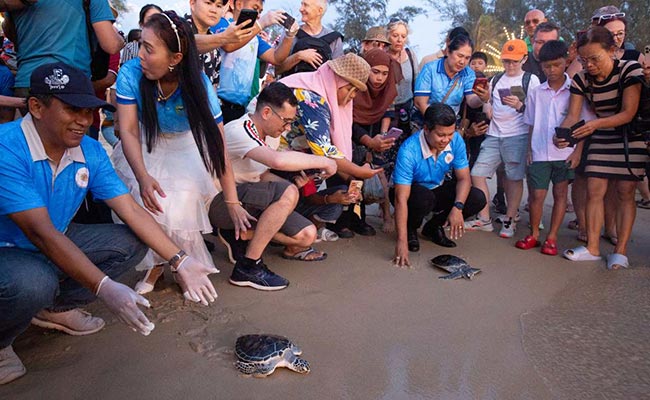
The ‘Prapanee Ploi Tao’ celebration takes place in March, when locals and visitors release young turtle hatchlings into the ocean. Image credit: Khao Lak Discovery
In March, a celebration known as ‘Prapanee Ploi Tao’ takes place, where locals and visitors release young turtle hatchlings into the ocean.
Spanning ten days from March 1st to March 10th, visitors eagerly gather to witness the poignant release of juvenile turtles into the sea, a symbol of collective dedication towards safeguarding these remarkable creatures and their habitats. Throughout the event, workshops and seminars, led by esteemed marine biologists and passionate conservationists, offer invaluable insights into turtle conservation, marine ecosystems, and the imperative need for environmental preservation.
From lively beach clean-ups to spirited art competitions and engaging turtle-themed games, attendees of all ages are invited to partake in activities designed to encourage environmental consciousness.
Of course the stalls are brimming with local cuisine and all manner of things to buy. As the sun sets, the festivities continue with nightly gatherings around beach bonfires, live music performances, and a bustling night market.
3. Visit Ban Ta Din Daeng
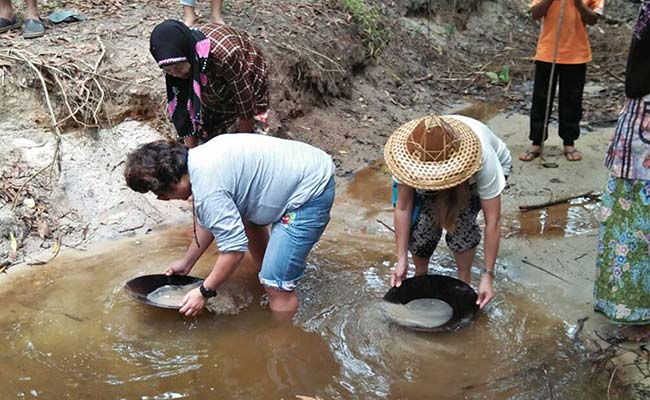
Locals demonstrate how they used to to separate the ore from the rocks and sand to sell back to the mine. Image credit: thailand. go. th
Ban Ta Din Daeng, located in Lum Kaen subdistrict, is a popular ecotourism destination. A key highlight of the community's history is the “billion-baht mine,” a legacy marked by a 100-year-old ore track and its structures. The remnants of this past, including well-preserved mining tools, offer a glimpse into the villagers' traditional lifestyle.
Villagers historically used a wooden tool called a “lieng,” resembling a wok, to separate tin ore from rocks and sand. This method provided a vital source of income as the separated ore was sold back to the mine.
This heritage of local wisdom is an important part of the community's identity. As a result, the community promotes it as a tourist activity, inviting visitors to explore the ancient ore track, learn about the prosperous history of the mining industry in Phang Nga, and experience the traditional ore separation technique (2).
Thai Mueang's Tin Mining History
The tin mining industry has played a significant role in the history and development of Thai Mueang. Tin mining has been a prominent economic activity in southern Thailand for centuries, shaping the landscape, economy, and social fabric of the area.
Historically, tin mining in Thai Mueang and Phang Nga Province dates back to the 16th century when Chinese immigrants introduced tin mining techniques to the region. The discovery of tin-rich deposits in riverbeds and alluvial plains attracted miners from various parts of Thailand and neighboring countries, leading to the establishment of mining communities and settlements.
During the late 19th and early 20th centuries, tin mining in Thai Mueang experienced a period of rapid expansion and industrialization, fueled by advancements in mining technology and increased demand for tin on the global market. Large-scale tin mining operations were established, employing thousands of workers and contributing significantly to the local economy.
The tin mining industry brought prosperity to Thai Mueang and neighboring areas, attracting migrant workers, entrepreneurs, and investors seeking opportunities in the booming tin trade.
However, the tin mining industry also had adverse environmental and social impacts on the region. Large-scale mining operations led to deforestation, soil erosion, and water pollution, affecting local ecosystems and natural habitats. Moreover, working conditions in tin mines were often harsh and dangerous, with miners facing risks of accidents, health hazards, and exploitation.
In recent decades, the tin mining industry in Thai Mueang and Phang Nga Province has declined due to depletion of tin reserves, stricter environmental regulations, and changes in global market dynamics. Many former tin mines have been abandoned or repurposed for other uses, while efforts are underway to rehabilitate and restore areas affected by mining activities.
4. Visit Leng San Keng Shrine
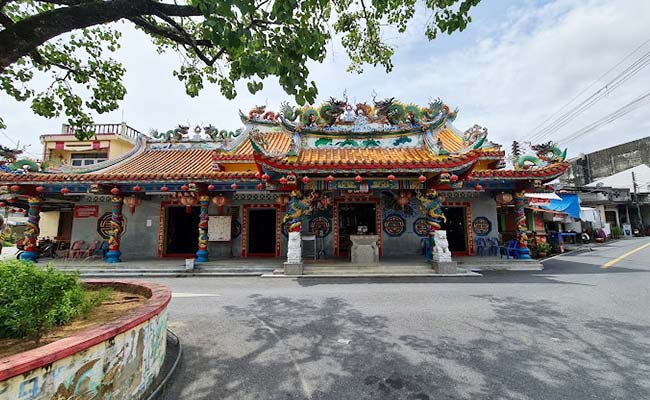
Leng San Keng Shrine, Thai Mueang
Another highly revered spiritual place in Thai Muang is the century-old Leng San Keng Shrine (ศาลเจ้าเล่งสั้นเก้ง). The shrine is a testament to the rich cultural heritage brought by the Hokkien people, who migrated to Phang Nga in the 19th century. These early settlers sought fortune in mining and trading, which led to significant Chinese influences in the local community.
Leng San Keng Shrine houses over ten gods, with the deified priest Cho Su Kong regarded as the head deity among them. The shrine is not only a place of worship but also a cultural hub where traditional Chinese festivals and rituals are observed. It stands as a symbol of the enduring legacy of the Hokkien settlers and their contributions to the region's cultural and spiritual landscape.
The architecture of Leng San Keng Shrine reflects traditional Chinese design, featuring intricate carvings, vibrant colors, and symbolic decorations that honor the deities and attract worshippers. During significant festivals like the Chinese New Year and the Vegetarian Festival, the shrine becomes a focal point for communal activities, drawing visitors from near and far to participate in the celebrations and pay homage to the gods.
5. Attend Thai Mueang Morning Market
I haven't been to this market, so I took the following recommendation from a Thai Mueang native named Gift. She has written a wonderful blog post about her return to the district after having been away for five years. You can read that here.
Thai Mueang Market (ตลาดสดเทศบาลท้ายเหมือง) begins before sun-up, and all manner of delights can be found here. It's also a chance to mix with the natives, many of whom have deep family ties to the area dating back before the mining industry.
Fresh produce is a given and you will also find a vast array of traditional Thai sweets, many exclusive to Southern Thailand. If you want to take your breakfast experience to the next level, I recommend the traditional southern-style coffee shop Kopi Tantaweesuk or โกปี๊ตันทวีสุข (Kopi means coffee in Southern Thai). Thai Muang locals call it Raan Go Giang or ร้านโกเกี๊ยง, though.
Housed in a family home made of wooden and zinc paneling, Raan Go Giang, translating to Go Giang’s shop (Go is a southern Thai word for brother and Giang is the actual name of the previous owner), is currently managed by the third generation, Go Giang’s daughter and her husband. The local favorite hangout since its opening by Go Giang’s father over 100 years ago, Raan Go Giang welcomes guests from dawn till dusk, but I love visiting in the morning the most.
Where to Stay in Thai Mueang
Thai Mueang is limited when it comes to hotel options, so don't expect a 5-star experience. However, here are two very affordable properties.
- The Thai Mueang Boutique Hotel: Probably your best option. It's quite dated but well kept and clean, and is designed in classic Sino-Thai character. The reviews are good.
- Thai Mueang Resort: A slightly cheaper option, and a little more basic, but adequate for a short stay. The reviews are mixed.
Free WIFI is available at both hotels.
Also check out Air B&B for more options.
Tips to Start Planning Your Trip:
Book Your Accommodation
Book your accommodation in Thailand at a discounted rate on Agoda
Don’t Forget Travel Insurance
You will need solid travel insurance, especially if you want to ride a motorbike. Most of us use SafetyWing.
Reserve Bus and Train Tickets
If you want to take a bus or train trip, reserve your tickets on 12GoAsia.com.
Last Updated on




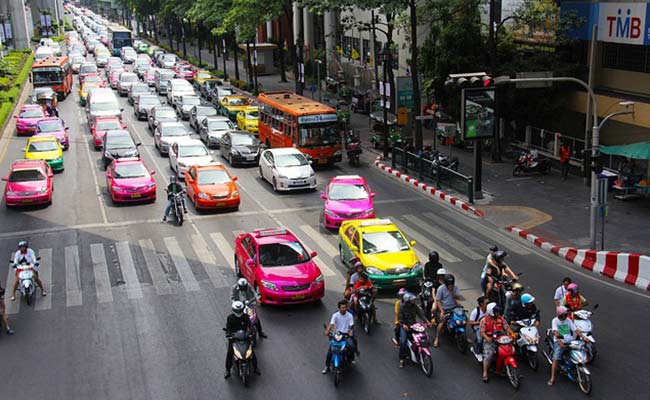
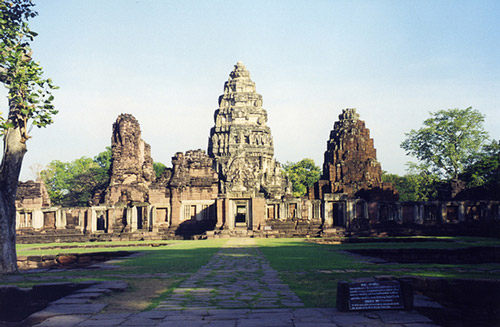
JamesE says
The beach is very nice but, dynamic, so your experience in the off season will be different than the flat-water picture postcard image seen in December - May. Even in good conditions the shelf drops off steeply so 10 meters out you will be in water well over your head.
The best cultural site (IMO) is Wat Tha Sai - the Temple on the Beach - a little south of town. There are two temple buildings with very interesting architecture with a strong Chinese influence. Adjacent to the temple grounds is the Sea Light Cafe, one of the more modern (and pricey) restaurants in the area but a great place to cool off after walking around the wat.
The town also boasts a lot of street art and murals, well worth a wander down some of the side streets.
Several of the restaurants along the beach are worth a visit - Pi Sao is Michelin mentioned, and comes with a higher price tag, but Bin Lah was my favorite dinner place. จิบแฟแลเล is a really nice breakfast place (open all day) and a favorite stop for bicyclists. It's also the only dessert place - ice cream cups - along the beach.
May 22, 2024 at 10:20 pm
TheThailandLife says
May 22, 2024 at 10:32 pm